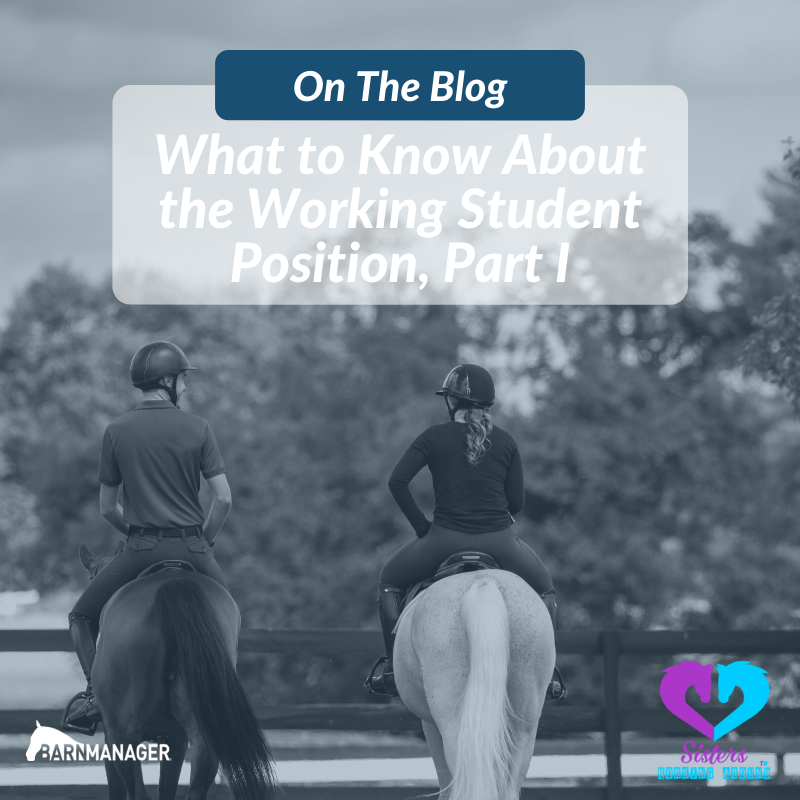
Help Wanted: How To Decide if the Working Student Position Is Right for You
Written by Emily and Sarah Harris

If you scroll through social media, you have probably seen a post seeking applications from anyone interested in becoming a working student at a barn, stable, or training facility. Perhaps your trainer or someone you know has offered you the position of a working student. If it’s something you’ve considered, we are here to educate you on what this title means and what a golden opportunity it can be. Working students are always needed, no matter the riding discipline or operation level.
What Is a Working Student?
A working student is a young person, typically a junior, who works in exchange for lessons and training. Responsibilities will typically include feeding, mucking stalls, cleaning up around the barn, cleaning tack, taking care of the horses, helping with lessons, and helping the staff, trainers, boarders, and students. Some positions may also include being capable of administering shots and medications, assisting the farrier when needed, operating farm equipment, farm-sitting, and helping out at horse shows, where you might be braiding, tacking up, grooming horses, holding horses, and more.
The job sounds like a lot, and it can be. But the benefits are endless. Some facilities might offer board for your horse or allow you the use of farm vehicles. Also, depending on the size and amenities available at the facility, you might be provided housing on the premises.
Overall, a working student position can be the perfect opportunity for learning and growth. You will get to work with different horses and be able to ride under the instruction of an expert. Doesn’t that sound great?
We have had the opportunity to be working students for several trainers in different disciplines as we’ve learned the ins and outs of the sport. Each trainer had different methods, so we learned something new with each opportunity.
If you are considering becoming a working student, here are some tips and advice to help you get the most out of your experience. We also want to be honest about the challenges so you are well prepared for what you may encounter.
Prioritize Communication
Communication is number one, not just as a working student but in all aspects of a training operation. Make sure that expectations are clear on both ends in the beginning and discuss all the details of the position before accepting the role. This is a great time to sort out things like job responsibilities and how often things like lessons will be provided in exchange for your work. It may be difficult to approach this subject because your excitement to accept can often overshadow the details, but you don’t want to accept a position and work hard and then receive less in return than you expected. This initial conversation about the details and benefits is also good because it helps you decide if this is a role that you will want to accept.
Also, once you know what the job responsibilities are, consider your abilities and limitations. Be upfront with yourself and the person for whom you will be working.
If you choose to accept the position, be sure to maintain open communication throughout your time of employment. If you are unsure about something or have concerns, speak up; don’t ignore the issue. It is better to discuss the issue than to push past your feelings and end up with a bad experience.
We can’t stress enough how important communication is, and good communication skills will serve you in all your equestrian endeavors for your entire life.
Consider the Cost
Always consider the cost of accepting a role as a working student. Your excitement might make you want to jump at the opportunity to get lessons without paying cash, but don’t rush into a position without carefully considering if it is worth your time and money.
Consider how much a lesson with that particular trainer would be. Also consider all the work you will be doing at the barn. In your opinion, is the input you give the same value as the output you receive? Think about commuting time and associated costs; they can both add up. Keep in mind any other possible benefits, such as the knowledge and experience you might not get otherwise. If you have any horses, is it better to bring them or leave them at home since you won’t have as much time to dedicate to them with your new responsibilities.
Everyone values the costs and benefits differently, so there is no “right” answer. The best-case scenario is that both you and the trainer will benefit from you joining the team, making it a win-win situation for everyone.
Make a Decision
If you need some time to think it over, don’t be afraid to ask if you can get back to the trainer with your answer. Be sure to give them a reasonable time frame for your decision and stick to it. You don’t want to keep your potential employer waiting because then he or she might ask someone else. After you have considered everything, talked it all over, and weighed both the advantages and disadvantages, you will be able to make an informed decision. Contemplate how this position may or may not be to your benefit, then tell the trainer your decision.
Moving forward
Stay tuned for our next blog post about what happens once you’ve been hired; that’s when the work truly starts. There are lots of things to keep in mind once you begin a working student position. Next, we will outline all of them for you!
Head to the Sisters Horsing Around website for more blogs, videos, and tips.
Have questions about utilizing BarnManager or want to give it a try for yourself? Request a live demo!